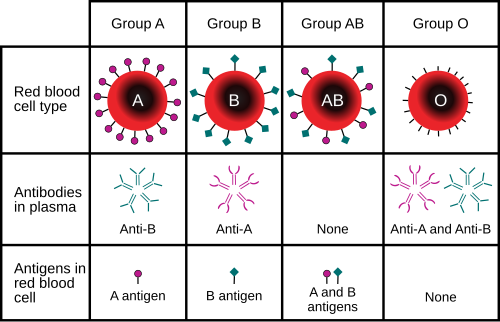Allele
An allele[1] is a variant of the sequence of nucleotides at a particular location, or locus, on a DNA molecule.[2]
Alleles can differ at a single position through single nucleotide polymorphisms (SNP),[3] but they can also have insertions and deletions of up to several thousand base pairs.[4]
Most alleles observed result in little or no change in the function or amount of the
Nearly all
Popular definitions of 'allele' typically refer only to different alleles within genes. For example, the ABO blood grouping is controlled by the ABO gene, which has six common alleles (variants). In population genetics, nearly every living human's phenotype for the ABO gene is some combination of just these six alleles.[5][6]
Etymology
The word "allele" is a short form of "allelomorph" ("other form", a word coined by British geneticists
Alleles that lead to dominant or recessive phenotypes
In many cases, genotypic interactions between the two alleles at a locus can be described as
The term "
Multiple alleles

A population or
For example, at the gene locus for the
Genotype frequencies
The frequency of alleles in a diploid population can be used to predict the frequencies of the corresponding genotypes (see Hardy–Weinberg principle). For a simple model, with two alleles;
where p is the frequency of one allele and q is the frequency of the alternative allele, which necessarily sum to unity. Then, p2 is the fraction of the population homozygous for the first allele, 2pq is the fraction of heterozygotes, and q2 is the fraction homozygous for the alternative allele. If the first allele is dominant to the second then the fraction of the population that will show the dominant phenotype is p2 + 2pq, and the fraction with the recessive phenotype is q2.
With three alleles:
- and
In the case of multiple alleles at a diploid locus, the number of possible genotypes (G) with a number of alleles (a) is given by the expression:
Allelic dominance in genetic disorders
A number of
Other disorders, such as Huntington's disease, occur when an individual inherits only one dominant allele.
Epialleles
While
Idiomorph
The term "idiomorph", from Greek 'morphos' (form) and 'idio' (singular, unique), was introduced in 1990 in place of "allele" to denote sequences at the same locus in different strains that have no sequence similarity and probably do not share a common phylogenetic relationship. It is used mainly in the genetic research of mycology.[18][19]
See also
References and notes
- ^ UK: /ˈæliːl, əˈliːl/; modern formation from Greek ἄλλος állos, "other"
- ^ Graur, D (2016). Molecular and Genome Evolution. Sunderland MA (USA): Sinauer Associates, Inc.
- PMID 10592272.
- PMID 22307690.
- PMID 12829588.
- S2CID 12076999.
- ^ Craft, Jude (2013). "Genes and genetics: the language of scientific discovery". Genes and genetics. Oxford English Dictionary. Archived from the original on 29 January 2018. Retrieved 14 January 2016.
- ^ Bateson, W. and Saunders, E. R. (1902) "The facts of heredity in the light of Mendel’s discovery." Reports to the Evolution Committee of the Royal Society, I. pp. 125–160
- ISBN 978-0-7637-3527-2.
- PMID 28696921.
- ^ "Allele". Genome.gov. Archived from the original on 28 June 2021. Retrieved 3 July 2021.
- ISBN 978-1-319-21680-1.
- ^ Victor A. McKusick; Cassandra L. Kniffin; Paul J. Converse; Ada Hamosh (10 November 2009). "ABO Glycosyltransferase; ABO". Online Mendelian Inheritance in Man. National Library of Medicine. Archived from the original on 24 September 2008. Retrieved 24 March 2010.
- PMID 12014997.
- S2CID 8654616.
- PMID 12127774.
- S2CID 36938621.
- PMID 1398049.
- S2CID 10818930.





